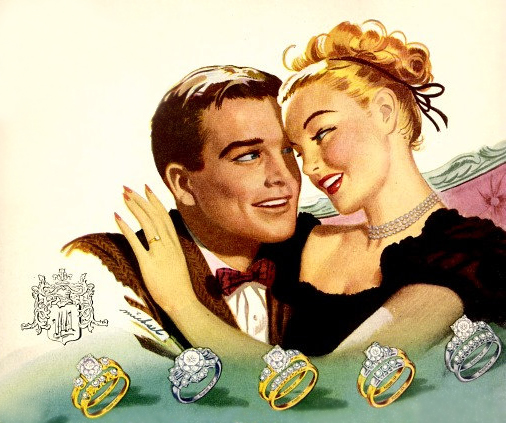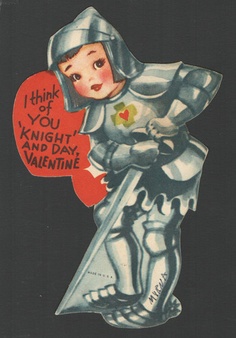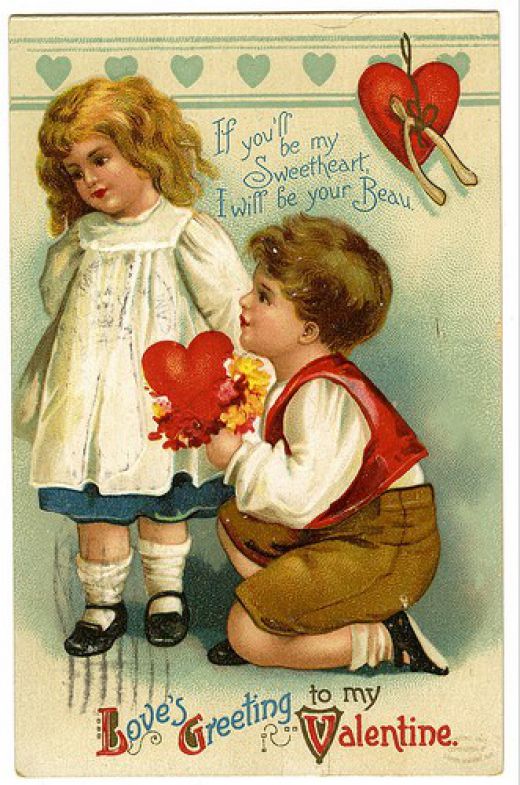With Valentine’s Day upon us once again, it’s a good time to recount the history of the occasion and highlight the gynocentric farce that it appears to have become… or more accurately that it has always been.
Let’s begin with a primer about what Valentine’s Day means for men, or rather what it should mean for men, according to advice columnist and relationship expert Brooke Miller. Here she addresses we men directly:
First lesson: Valentine’s Day matters. This really isn’t debatable my darlings, just trust me on this one. Second lesson: Valentine’s Day matters because… Because it’s not really about Valentine’s Day…it’s a metaphor. Really? Yes, really.
Valentine’s Day is a metaphor for every other moment throughout the entire duration of your relationship when the woman in your life needs and wants and hopes you are able to joyfully and proudly step out of your way, and make it about her.
Valentine’s Day is a holiday decorated with girly-pink-sparkly-chocolate-flowery-hearts…and and and. February 14th could not be less stereotypically masculine if it tried. Although this holiday may not be about you, it is in fact, for you. It gifts you the opportunity to demonstrate the kind of guy you can be when put in a situation that is not about you. It shows that beautiful human being you’re lucky to be with that you, you amazing man, are able to show up selflessly to any occasion.
Valentine’s Day gives your crush or girlfriend or fiancé or wife, either a taste or a reminder (women love being reminded) of your ability to care about things not because you care about them, but because you care about her… and she cares about things. Get it?
Women know very well that Valentine’s Day doesn’t particularly matter to you, but making it matter to you, simply and solely for her… now that’s a guy worth being with.
An acknowledgment of the day, a card, flowers, or even a romantic gift like a massage or spa treatment (hint hint) shows your capacity to put yourself aside even if she doesn’t ask you to–especially if she doesn’t ask you to… and put her first.1
So there you have it gents; on Valentine’s Day step the fuck out of your own way and make it all about her, and while you are at it get rid of your preconceived notions that say love is meant to be bi-directional. And if you end up marrying one of the many narcissistic princesses who expect this kind of treatment make sure to remember that the day of your marriage, too, is “her day.” In fact why beat around the bush – marriage to her will mean every single day of the rest of your life will probably be “her days” too.
But getting back to Valentine’s Day, lets take a little look at the background of this gynocentric event.
Valentine’s Day, the celebration of romantic love, first became popular in the High Middle Ages when the traditions of courtly love arose, and has been celebrated as a holiday ever since. However the precise origins of the concept are somewhat unclear, and the situation is made more complicated by the fact that there are no less than three Saint Valentines in the historical folklore.
The first written Valentine note was believed to be by Charles the Duke of Orleans who in 1415 AD, while imprisoned in the Tower of London, sent a love letter to his wife. An excerpt from that letter still exists in the British Library’s collection and reads “I am already sick from love, My very gentle Valentine.” The date became further associated with romantic and courtly love when Geoffrey Chaucer incorporated St. Valentine’s Day into his love poem “The Parliament of Foules.” Chaucer, who wrote the love poem to commemorate the engagement of Richard II and Anne of Bohemia, linked the royal engagement with the pairing of birds and Valentine’s Day. The holiday was also mentioned in Shakespeare’s Hamlet, as well as by the poet John Donne, and has since evolved into what most would now consider the most romantic day of the year. Perhaps the most famous Valentine’s poem is this one published in Gammer Gurton’s Garland, a 1784 collection of English rhymes:
The honey’s sweet, and so are you.
Thou are my love and I am thine;
I drew thee to my Valentine:
The lot was cast and then I drew,
And Fortune said it shou’d be you.
.
The tradition of exchanging gifts and tokens was established during the height of romantic love when people began to select their own Valentine’s mates, and the tradition began to appear frequently in love poetry. The elaborate exchanges of poetry, cards, and gifts cemented it as a holiday for the celebration of love in European popular culture. Valentine’s Day has since spread all over the world, and most nations still celebrate it on the 14th of February with flowers, gifts, and cards.
The soil in which the celebration bloomed celebrated love as illicit, passionate, morally elevating, transcendent, if at times painful and humiliating: the perfect recipe for an affair. Participants adopted the language of feudalism with chivalric men declaring themselves “love servants” who pledged themselves in submission, obedience, and utility to ladies whom they worshipped as both their overlord and moral superior. This feudalisation of love -so called by C.S. Lewis- was popularized by troubadours in poems and songs, providing both the model and the spirit we continue to express on Valentine’s Day.
“Valentine’s Day gives your crush or girlfriend or fiancé or wife, either a taste or a reminder of your ability to care about things not because you care about them, but because you care about her… and she cares about things.” [Brooke Miller]1
 By the 18th century it had become a widespread custom for men in all social classes to exchange small tokens of affection or handwritten notes on February 14. In the Victorian era, printed cards replaced written letters as a way to express emotions, encouraged both by improvements in printing technology and cheaper postage rates. In the 1840s, Esther A. Howland began to sell the first mass-produced valentines in America. This practice was extended in the 20th century to all manners of gifts, especially in the United States. With the advent of consumerism in post-war America, Valentine’s Day became a day of gift-giving, from roses and chocolates to diamonds, and the immense popularity of the event tells us that the spirit of chivalry and courtly love is far indeed from being over.
By the 18th century it had become a widespread custom for men in all social classes to exchange small tokens of affection or handwritten notes on February 14. In the Victorian era, printed cards replaced written letters as a way to express emotions, encouraged both by improvements in printing technology and cheaper postage rates. In the 1840s, Esther A. Howland began to sell the first mass-produced valentines in America. This practice was extended in the 20th century to all manners of gifts, especially in the United States. With the advent of consumerism in post-war America, Valentine’s Day became a day of gift-giving, from roses and chocolates to diamonds, and the immense popularity of the event tells us that the spirit of chivalry and courtly love is far indeed from being over.
While some couples might equally indulge each other on this auspicious occasion, more often than not it will be a day on which the man will worship a woman as his true overlord, with himself playing the role of gift-giving serf. Perhaps Valentine’s Day will one day be worth celebrating if it becomes a reciprocal event, but until then the best advice for men on Vagina Day Valentine’s Day will be to reframe the event as Go Your Own Way Day.
[1] Brooke on Boys: Why Valentine’s Day Matters, Primer Magazine: A Guy’s Post-College Guide to Growing Up.



